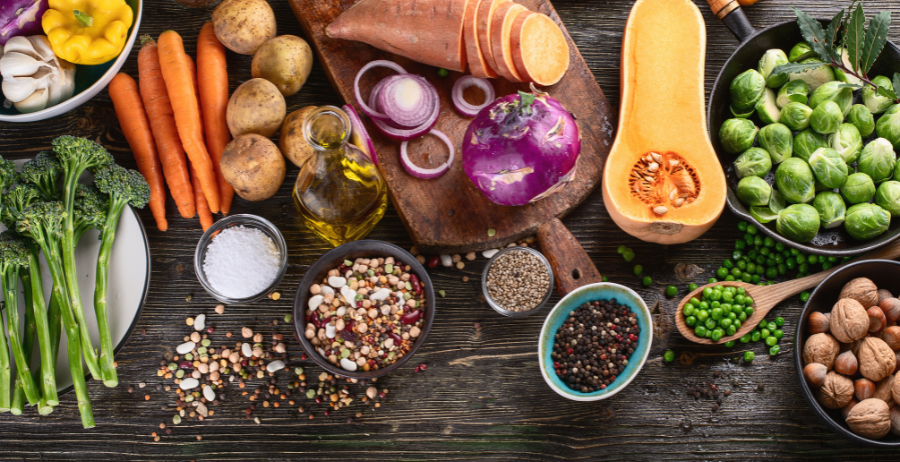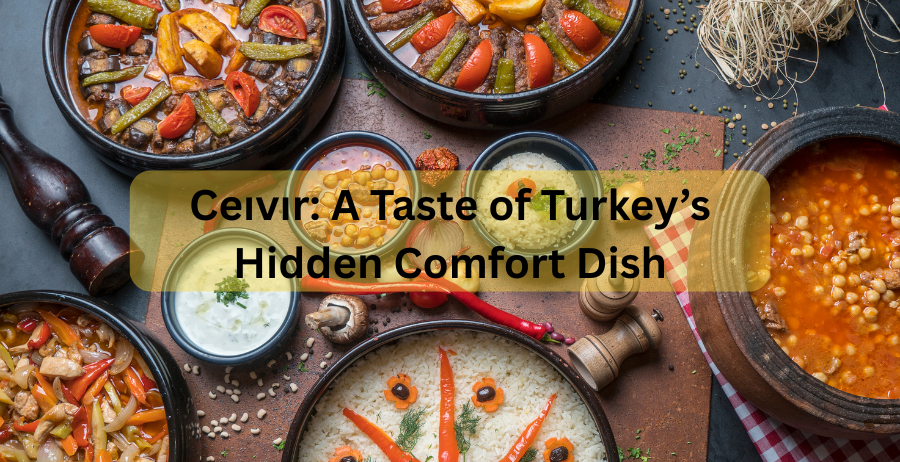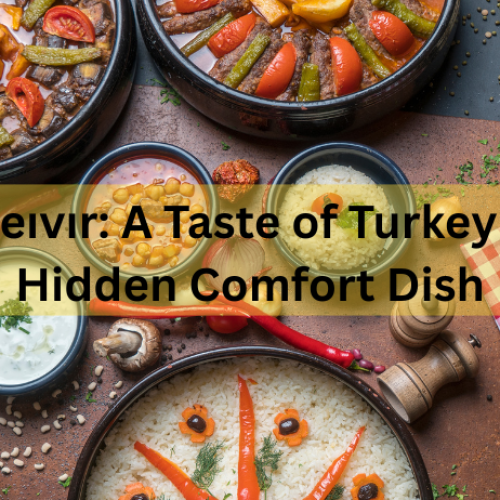Steam rises in soft curls, carrying the scent of toasted cumin and fresh parsley. A spoonful of butter sizzles, releasing a nutty perfume that fills the room. Chopped peppers flash red and green against golden bulgur, while tender pieces of lamb soak up every spice. This is Ceıvır a Turkish comfort dish that gathers family and friends around one fragrant pot.
Each bite tells of Anatolian hills, market stalls bright with herbs, and centuries of shared meals. Simple ingredients, slow heat, deep flavor. You don’t just eat Ceıvır; you breathe it in, feel its warmth, and taste a tradition kept alive in kitchens across Turkey and beyond.
Table of Contents
ToggleWhat Does “Ceıvır” Mean? Etymology & Names
Ceıvır (pronounced jeh-veer or sometimes seh-veer depending on regional accent).It is more than a recipe name it’s a little piece of Turkish history. Linguists trace it to old Anatolian Turkish where the root çevir means to turn or to stir. That fits the dish perfectly meat, grain, and vegetables slowly turned together until every bite shares the same rich flavor.
You may also see it written as Ceivir, Ceyvir, or Çevir, all reflecting different ways of capturing the Turkish ı,a vowel sound without an exact English match. Locals pronounce it with a soft, back-of-the-throat “uh,” giving the word a gentle, earthy tone much like the meal itself. So when you say Ceıvır, you are speaking a word that carries centuries of kitchens, firesides, and family tables in just a few syllables.
Historical & Cultural Roots
Centuries ago, nomadic herders crossed the windswept plains of central Anatolia carrying only grain, spices, and freshly butchered lamb. They needed a meal that traveled well and nourished tired bodies. So they stirred everything into a single pot over open fire. The result became Ceıvır a dish built for long journeys and cool mountain nights.
Over time, villagers brought Ceıvır from campfires to family tables. It became a centerpiece for weddings, harvest feasts, and religious holidays, symbolizing abundance and togetherness. Today, whether served in bustling Istanbul kitchens or quiet rural homes. Each pot of Ceıvır still carries the warmth of shared history and the quiet pride of Turkish tradition.
Just like Mannacote, another comforting dish loved for its tradition, Ceıvır brings families together with flavors that speak to heritage and warmth.
Ingredients & Step-by-Step Guide

Making Ceıvır starts with fresh, honest ingredients and a simple method that lets their flavors shine. Here is everything you need and how to bring it together.
Ingredients
- Lamb or beef (500 g): Choose shoulder or leg for tender, juicy bites.
- Bulgur (1 cup): Medium-coarse grain gives the best texture; rinse before cooking.
- Onion (1 large) & Garlic (2 cloves): The flavor base sweet and savoury.
- Tomatoes (2) & Peppers (1–2): Add brightness and a gentle kick.
- Olive oil & Butter (2 tbsp. each): For rich, layered taste.
- Spices: 1 tsp cumin, ½ tsp paprika, pinch of black pepper, salt to taste.
- Fresh herbs: Parsley or dill for a fragrant finish.
Method
The heart of Ceıvır lies in slow cooking and patient stirring a steady rhythm that coaxes every ingredient into harmony. Take your time and enjoy the aroma as each layer builds its own depth.
- Heat the base: Warm the olive oil and butter in a heavy pot over medium heat until the butter melts and sizzles.
- Create the foundation: Add the onion and garlic, sautéing until they turn golden and fragrant.
- Brown the meat: Drop in the diced lamb or beef, searing on all sides so the natural juices lock in flavor.
- Brighten the pot: Stir in tomatoes and peppers; cook until they soften and release their juices.
- Spice and grain: Sprinkle in cumin, paprika, black pepper, and salt. Add the rinsed bulgur and enough hot water or broth to just cover the mixture.
- Slow simmer: Cover and let it bubble gently, stirring now and then, until the bulgur drinks in the liquid and the meat is melt-in-the-mouth tender—about 25–30 minutes.
- Finish with freshness: Scatter chopped parsley or dill on top.
Lift the lid and inhale your Ceıvır is ready. Rich and aromatic a show-stopping dish worthy of any table.
Serving & Pairing Suggestions
Serve Ceıvır while it is still bubbling, letting the steam carry its spice-laced aroma across the table. Ladle it into wide, shallow bowls so the grains and tender meat shine.
- A chilled glass of ayran the classic Turkish yogurt drink balances the dish’s earthy warmth, while a crisp cucumber-mint salad adds a refreshing bite.
- For bread lovers, warm pide or crusty sourdough is ideal for soaking up the flavorful broth.
- If you prefer something heartier pair Ceıvır with roasted vegetables or a simple green bean side dressed in olive oil and lemon.
- Finish the meal with sweet Turkish tea or a small plate of dried apricots for a gentle, traditional close.
Every pairing enhances the dish’s rustic character. Turning a humble pot of grains and meat into a feast that feels both comforting and celebratory.
Regional Variations & Modern Twists
Across Turkey, every region gives Ceıvır its own signature. In the East, cooks favor bold spices extra cumin, red pepper flakes, and a touch of smoky paprika for deep heat. Along the Aegean coast, fresh herbs shine: mint, dill, and plenty of olive oil create a lighter, garden-bright flavor. In the misty Black Sea region, locals add corn or wild greens for an earthy twist that reflects the lush landscape.
Modern chefs continue the tradition of adaptation. Some swap lamb for slow-braised beef or even hearty mushrooms for a vegetarian take. Others finish the dish with pomegranate seeds or a drizzle of tahini for a sweet-savory contrast. Whether rustic or reinvented, these variations keep Ceıvır alive and evolving, proving a centuries-old recipe can stay exciting today.
Health & Nutrition
Rich in flavor and naturally well-balanced, Ceıvır offers a nourishing mix of protein, fiber, and essential nutrients. Here’s a quick, at-a-glance guide to its key benefits and simple ways to keep it wholesome:
| Element | Benefits / Key Facts | Tips for a Healthier Plate |
| Protein | 20–25 g per cup from lamb or beef it supports muscle repair | Choose lean cuts; trim visible fat |
| Bulgur Grain | Complex carbs + 6 g fiber gives steady energy, aids digestion | Rinse well and swap half for brown rice for variety |
| Vegetables | Tomatoes, peppers, onions supply vitamin C and antioxidants | Add extra peppers or seasonal greens for more micronutrients |
| Olive Oil | Heart-healthy monounsaturated fats | Measure oil to avoid excess calories |
| Fresh Herbs | Parsley, dill provide vitamins A and K, bright flavor | Add at the end to preserve nutrients |
| Sodium | Can rise with broth or heavy salting | Season gradually; taste before adding extra salt |
Enjoyed with a crisp salad or cool yogurt drink, Ceıvır becomes a satisfying, nutrient-dense meal that fits beautifully into everyday eating.
Beyond its taste, Ceıvır also carries nutritional benefits. If you’re curious about other healthy food choices, check out our Superfood Guide on LWSpeakCare and its importance.
Ceıvır Beyond Turkey
Around the world, home cooks embrace Ceıvır with their own creative twists. In Turkish diaspora kitchens across Europe and North America lamb often gives way to beef or chicken .While locally grown herbs replace hard-to-find Anatolian spices. Vegetarian chefs reimagine the dish with portobello mushrooms or chickpeas, letting bulgur and smoked paprika provide depth.
In Pakistan, families sometimes add green chillies and garam masala, creating a vibrant fusion that reflects both cuisines’ love of bold flavor. Mediterranean cooks stir in olives or sun-dried tomatoes while health-conscious eaters swap bulgur for quinoa for extra protein.
Each adaptation keeps Ceıvır’s spirit alive, a hearty one-pot meal that welcomes experimentation and celebrates local taste.
Conclusion
Few dishes capture comfort and tradition quite like Ceıvır. From its nomadic Anatolian roots to the creative twists found in kitchens around the world. This humble one-pot meal proves that simple ingredients can create extraordinary flavor. Each spoonful carries the warmth of slow cooking, the brightness of fresh herbs, and the satisfaction of sharing food made with care.
Now it is your turn to bring that heritage to your own table. Gather the grain, meat, and spices, let the pot simmer and fill your home with the aromas of Turkey. Invite family or friends, serve it steaming and watch how Ceıvır turns an ordinary evening into a celebration of flavor and togetherness.
FAQs:
What Exactly Is Ceıvır?
A traditional Turkish one-pot meal of meat, bulgur, vegetables, and spices, Ceıvır is slow-simmered until every ingredient shares the same rich flavor.
How Is Ceıvır Different From Pilaf Or Other Grain Dishes?
Unlike plain pilaf, Ceıvır cooks meat, vegetables, and bulgur together, creating a hearty, stew-like texture with deep, integrated seasoning.
Can I Make A Vegetarian Or Vegan Version?
Absolutely. Replace lamb or beef with mushrooms, chickpeas, or lentils, and use vegetable broth for a plant-based twist without losing the signature aroma.
What Meat Works Best?
Lamb shoulder is classic for its tenderness and flavor. But beef or chicken thighs are excellent alternatives when lamb is unavailable.
How Do I Store And Reheat Leftovers?
Cool completely, then refrigerate in an airtight container for up to three days. Reheat gently on the stove with a splash of water or broth to keep grains moist.
Any Quick Tips For First-Time Cooks?
Brown the meat well before adding bulgur, and season gradually. A slow simmer is key to marrying flavors and achieving Ceıvır’s rustic, comforting character.







